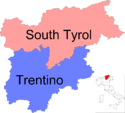South Tyrol
South Tyrol
Autonome Provinz Bozen — Südtirol Provincia autonoma di Bolzano — Alto Adige Provinzia autonoma de Balsan/Bulsan — Südtirol | |
|---|---|
 Map highlighting the location of the province of South Tyrol in Italy (in red) | |
| Country | |
| Region | Trentino-Alto Adige/Südtirol |
| Capital(s) | Bolzano |
| Comuni | 116 |
| Government | |
| • President | Luis Durnwalder (SVP) |
| Area | |
| • Total | 7,399.97 km2 (2,857.14 sq mi) |
| Population (2009) | |
| • Total | 500,030 |
| • Density | 68/km2 (180/sq mi) |
| Time zone | UTC+1 (CET) |
| • Summer (DST) | UTC+2 (CEST) |
| Postal code | 39XXX |
| Telephone prefix | 0471, 0472, 0473, 0474 |
| Vehicle registration | BZ |
| ISTAT | 021 |
South Tyrol (German and Ladin: Südtirol, Italian: Sudtirolo), also known by its Italian name Alto Adige, is an autonomous province in northern Italy. It is one of the two autonomous provinces that make up the autonomous region of Trentino-Alto Adige/Südtirol. The province has an area of 7,400 square kilometres (2,857 sq mi) and a total population of more than 500,000 inhabitants. Its capital is the city of Bolzano (German: Bozen; Ladin: Balsan or Bulsan).
The majority of the population speak German. Around a quarter of the population speak Italian, and a small minority have Ladin as their mother language.
Unlike almost all other provinces of Italy, South Tyrol is granted a considerable level of self-government, consisting of a large range of exclusive legislative powers and a fiscal regime that allows the province to retain 90% of all levied taxes.
In the wider context of the European Union, the province is one of the three members of the Euroregion of Tyrol-South Tyrol-Trentino, which corresponds almost exactly to the historical region of Tyrol.[1]
Name
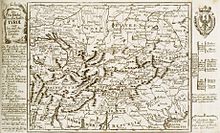
The two names most commonly used in English for the province — South Tyrol and Alto Adige — reflect the complex geopolitical history of the area.
South Tyrol (occasionally South Tirol) is commonly used, as the province was created from a portion of the southern part of the historic County of Tyrol. South Tyrol, despite its ethnic majority of German-speakers, was annexed by Italy from Austria-Hungary after the end of World War I under the Treaty of Saint-Germain in 1919.
Alto Adige (English: "Upper Adige") derives from the French Haut-Adige, a term that dates from when Napoleon Bonaparte annexed the southern parts of Tyrol (today's Trentino and the area around Bolzano) from the Austrian Empire and ruled Italy from 1805 to 1814. He renamed the area after the Adige (Etsch) River which flows through the region. Renaming the region after a geographic feature was an attempt to erase any affiliation to the County of Tyrol.[2] The term was reintroduced as the name of the German-speaking areas south of the Brenner Pass after their annexation by Italy, and was a symbol of the forced Italianization of South Tyrol prior to World War II.[3]
The official name of the province today in German is Autonome Provinz Bozen — Südtirol. German speakers refer to it simply as Südtirol and usually refer to it not as a Provinz, but as a Land (such as the Länder of either Germany or Austria).[4] Provincial institutions are referred to using the prefix Landes-, such as Landesregierung (Provincial Government) or Landeshauptmann (President of the Province).[5] The official name in Italian is Provincia autonoma di Bolzano — Alto Adige, but is usually known as Alto Adige or increasingly Sudtirolo[6] (sometimes spelled Sud Tirolo[7]).
History
Italian annexation of 1919
South Tyrol is an administrative entity whose origins go back to World War I. In 1915, the Entente promised the area to Italy in London as an incentive to enter the war on their side. Until 1918 part of the Austro-Hungarian Princely County of Tyrol, this almost completely German-speaking territory was occupied by Italy at the end of the war in November 1918 and was annexed in 1919. The province as it exists today was created in 1926 after an administrative reorganization of the Kingdom of Italy and was incorporated together with the province of Trent into the newly created region Venezia Tridentina.

Under the fascist government, huge efforts were made to bring forward the Italianization of South Tyrol. The German language was banished from public service, German teaching was officially forbidden and German newspapers were censored with the exception of the fascist Alpenzeitung. The regime massively favoured immigration from other Italian regions.
The subsequent alliance between Adolf Hitler and Benito Mussolini declared that South Tyrol would not follow the destiny of Austria, which had been annexed to the Third Reich. Instead the dictators agreed that the German-speaking population be transferred to German-ruled territory or dispersed around Italy, but the outbreak of the Second World War prevented them from fully carrying out their relocation.
In 1943, when the Italian government signed an armistice with the Allies, the region was occupied by Germany, which reorganised it as the Operation Zone of the Alpine Foothills and put it under the administration of Gauleiter Franz Hofer. The region was de facto annexed to the German Reich (with the addition of the province of Belluno) until the end of the war. This status ended along with the Nazi regime, and Italian rule was restored in 1945.
Gruber-De Gasperi Agreement
After the war the Allies decided that the province would remain a part of Italy, under the condition that the German-speaking population be granted an important level of self-government. Italy and Austria negotiated an agreement in 1946, recognizing the rights of the German minority. Alcide De Gasperi, Italy's prime minister, a native of Trentino, wanted to extend the autonomy to his fellow citizens. This led to the creation of the region called Trentino-Alto Adige/Tiroler Etschland. The Gruber-De Gasperi Agreement was signed by the Italian and Austrian Foreign Ministers, creating the autonomous region of Trentino-South Tyrol, consisting of the autonomous provinces of Trentino and South Tyrol. German and Italian were both made official languages, and German-language education was permitted once more. However, as the Italians were the majority in the combined region, the self-government of the German minority became impossible.
This, together with the arrival of new Italian-speaking immigrants, led to strong dissatisfaction among South Tyroleans, which culminated in terrorist acts perpetrated by the Befreiungsausschuss Südtirol (BAS — Committee for the Liberation of South Tyrol). In a first phase only public edifices and fascist monuments were targeted. The second phase was bloodier, costing 21 lives (15 members of Italian uniformed services, 2 civilians and 4 terrorists).
Südtirolfrage
The South Tyrolean question (Südtirolfrage) became an international issue. As the implementation of the post-war agreement was not seen as satisfactory by the Austrian government, it became a cause of significant friction with Italy and was taken up by the United Nations in 1960. A fresh round of negotiations took place in 1961 but proved unsuccessful, partly because of the campaign of terrorism.
The issue was resolved in 1971, when a new Austro-Italian treaty was signed and ratified. It stipulated that disputes in South Tyrol would be submitted for settlement to the International Court of Justice in The Hague, that the province would receive greater autonomy within Italy, and that Austria would not interfere in South Tyrol's internal affairs. The new agreement proved broadly satisfactory to the parties involved and the separatist tensions soon eased.
The new autonomous status, granted from 1972 onwards, has resulted in a considerable level of self-government, also due to the large financial resources of South Tyrol, retaining almost 90% of all levied taxes.[8]
Autonomy

Italy and Austria officially ended their dispute with an autonomy agreement in 1992.[9] Since the new statute of autonomy came into force, the province has undergone considerable development and is nowadays one of the richest regions in Italy.[10]
The extensive self-government provided by the current institutional framework has been advanced as a model for settling interethnic disputes and for the successful protection of linguistic minorities.[11] This is among the reasons why the Ladin municipalities of Cortina d'Ampezzo/Anpezo, Livinallongo del Col di Lana/Fodom and Colle Santa Lucia/Col have asked in a referendum to be detached from Veneto and reannexed to the province, from which they were separated under the fascist government.
Euroregion

In 1996, the Euroregion Tyrol-South Tyrol-Trentino was formed between the Austrian state of Tyrol and the Italian provinces of South Tyrol and Trentino. The boundaries of the association correspond to the old County of Tyrol. The aim is to promote regional peace, understanding and cooperation in many areas. The region's assemblies meet together as one on various occasions and have set up a common liaison office to the European Union in Brussels.
Geography
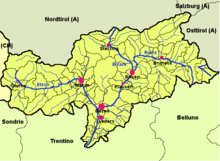
South Tyrol is located at the northernmost point in Italy. The province is bordered by Austria to the east and north, specifically by the Austrian federal-states Tyrol and Salzburg, and by Switzerland (canton of Grisons) to the west. The Italian provinces of Trentino, Belluno, and Sondrio border to the southeast, south, and southwest, respectively.
The landscape itself is mostly cultivated with different types of shrubs and forests and is highly mountainous.
Entirely located in the Alps, the province's landscape is dominated by mountains. The highest peak is the Ortler (3,905 m) in the far west, which is also the highest peak in the Eastern Alps outside the Bernina range. Even more famous are the craggy peaks of the Dolomites in the eastern part of the region.
The following mountain groups are (partially) in South Tyrol. All but the Sarntal Alps are on the border with Austria, Switzerland, or other Italian provinces. The ranges are clockwise from the west and for each the highest peak is given that is within the province or on its border.

| Name | Highest peak (German/Italian) | metres | feet |
|---|---|---|---|
| Ortler Alps | Ortler/Ortles | 3,905 | 12,811 |
| Sesvenna Range | Muntpitschen/Monpiccio | 3,162 | 10,374 |
| Ötztal Alps | Weißkugel/Palla Bianca | 3,746 | 12,291 |
| Stubai Alps | Wilder Freiger/Cima Libera | 3,426 | 11,241 |
| Sarntal Alps | Hirzer/Punta Cervina | 2,781 | 9,124 |
| Zillertal Alps | Hochfeiler/Gran Pilastro | 3,510 | 11,515 |
| Hohe Tauern | Dreiherrnspitze/Picco dei Tre Signori | 3,499 | 11,480 |
| Eastern Dolomites | Dreischusterspitze/Punta Tre Scarperi | 3,152 | 10,341 |
| Western Dolomites | Langkofel/Sassolungo | 3,181 | 10,436 |
Located in between the mountains are a large number of valleys, which is where the majority of the population lives. See Valleys of South Tyrol.
Administrative divisions
The province is divided into eight districts (German: Bezirksgemeinschaften, Italian: comunità comprensoriali), one of them being the capital city of Bolzano. Each district is headed by a president and two bodies called the district committee and the district council. The districts are responsible for intermunicipal disputes, roads, schools and social services such as retirement homes.
The province is further divided into 116 Gemeinde or comuni (see Municipalities of South Tyrol).[12]
Districts
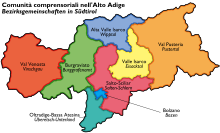
| District (German/Italian) | Capital (German/Italian) | Area | Inhabitants |
|---|---|---|---|
| Bozen/Bolzano | Bozen/Bolzano | 52 km² | 100,808 |
| Burggrafenamt/Burgraviato | Meran/Merano | 1,101 km² | 88,300 |
| Überetsch-Unterland/Oltradige-Bassa Atesina | Neumarkt/Egna | 424 km² | 63,000 |
| Salten-Schlern/Salto-Sciliar | Bozen/Bolzano | 1,037 km² | 44,400 |
| Eisacktal/Valle Isarco | Brixen/Bressanone | 624 km² | 44,500 |
| Pustertal/Val Pusteria | Bruneck/Brunico | 2,071 km² | 73,000 |
| Vinschgau/Val Venosta | Schlanders/Silandro | 1,442 km² | 34,307 |
| Wipptal/Alta Valle Isarco | Sterzing/Vipiteno | 650 km² | 18,220 |
Largest municipalities


| Municipality (German) | Municipality (Italian) | Municipality (Ladin) | Inhabitants |
|---|---|---|---|
| Bozen | Bolzano | Bulsan | 100,629 |
| Meran | Merano | 36,811 | |
| Brixen | Bressanone | Persenon | 19,786 |
| Leifers | Laives | 16,161 | |
| Bruneck | Brunico | Bornech | 14,535 |
| Eppan an der Weinstraße | Appiano sulla Strada del Vino | 13,518 | |
| Lana | Lana | 10,706 | |
| Kaltern an der Weinstraße | Caldaro sulla Strada del Vino | 7,411 | |
| Ritten | Renon | 7,208 | |
| Sarntal | Sarentino | 6,760 | |
| Kastelruth | Castelrotto | 6,288 | |
| Sterzing | Vipiteno | 5,985 | |
| Schlanders | Silandro | 5,930 | |
| Ahrntal | Valle Aurina | 5,711 | |
| Naturns | Naturno | 5,274 | |
| Latsch | Laces | 5,083 | |
| Sand in Taufers | Campo Tures | 5,040 | |
| Klausen | Chiusa | 5,001 | |
| Mals | Malles | 4,996 | |
| Neumarkt | Egna | 4,744 | |
| St.Ulrich | Ortisei | Urtijëi | 4,604 |
| Algund | Lagundo | 4,228 | |
| Ratschings | Racines | 4,107 | |
| Terlan | Terlano | 4,010 |
Climate


Climatically South Tyrol may be divided into five distinct groups:
The Etsch valley area, with cold winters (24-h averages in January of about 0°C) and warm summers (24-h averages in July of about 23°C), usually classified as Humid subtropical climate — Cfa. It is the driest and sunniest climate of the province. The main city in this area is Bolzano.
The midlands between 300 and 900 metres, with cold winters (24-h averages in January between -3°C and 1°C) and mild summers (24-h averages in July between 15°C and 21°C); This is a typical Oceanic climate, classified as Cfb. It is usually wetter than the subtropical climate, and very snowy during the winters. During the spring and autumn, there is a large foggy season, but fog may occur even on summer mornings. Main towns in this area are Merano, Bruneck, Sterzing, Brixen. Near the lakes in higher lands (between 1000 and 1400 meters) the humidity may make the climate in these regions milder during winter, but also cooler in summer, then, a Subpolar oceanic climate, Cfc, may occur.
The alpine valleys between 900 and 1400 metres, with a typically Humid continental climate — Dfb, covering the largest part of the province. The winters are usually very cold (24-h averages in January between -8°C and -3°C), and the summers, mild with averages between 14 and 19°C. It is a very snowy climate; snow may occur from early October to April or even May. Main municipalities in this area are Urtijëi, Badia, Sexten, Toblach, Stilfs, Vöran, Mühlwald.
The alpine valleys between 1400 and 1700 metres, with a Subarctic climate — Dfc, with harsh winters (24-h averages in January between -9°C and -5°C) and cool, short, rainy and foggy summers (24-h averages in July of about 12°C). These areas usually have five months below the freezing point, and snow sometimes occurs even during the summer, in September. This climate is the wettest of the province, with large rainfalls during the summer, heavy snowfalls during spring and fall. The winter is usually a little drier, marked by freezing and dry weeks, although not sufficiently dry to be classified as a Dwc climate. Main municipalities in this area are Corvara, Sëlva, Santa Cristina Gherdëina.
The highlands above 1700 meters, with an alpine Tundra climate, ET, which becomes an Ice Cap Climate, EF above 3000 meters. The winters are cold, but sometimes not as cold as the higher valleys' winters. In January, most of the areas at 2000 meters have an average temperature of about -5°C, while in the valleys at about 1600 meters, the mean temperature may be as low as -8 or -9°C. The higher lands, above 3000 meters are usually extremely cold, with averages of about -14°C during the coldest month, January.
Politics
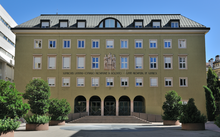

The local government system is based upon the provisions of the Italian Constitution and the Autonomy Statute of the Region Trentino-Alto Adige/Südtirol.[13] The 1972 second Statute of Autonomy for Trentino-Alto Adige/Südtirol devolved most legislative and executive competences from the regional level to the provincial level, creating de facto two separate regions.
The considerable legislative power of the province is vested in a provincial assembly (German: Südtiroler Landtag;[14] Italian: Consiglio della Provincia Autonoma di Bolzano;[15] Ladin: Cunsëi dla Provinzia Autonoma de Bulsan).[16] The legislative powers of the provincial assembly cover all those subject matters that are not expressly reserved to the exclusive legislative power of the Italian State or to concurrent legislation per article 117 of the Italian Constitution.
The executive powers are attributed to the provincial government (German: Landesregierung;[17] Italian: Giunta Provinciale[18]) headed by the Landeshauptmann Luis Durnwalder, who has been in power since 1989. He belongs to the South Tyrolean People's Party, which has been governing with absolute majority since 1945.
|
List of governors
- Karl Erckert (SVP), 20 December 1948 – 15 December 1955
- Alois Pupp (SVP), 7 January 1956 – 31 December 1960
- Silvius Magnago (SVP), 31 December 1960 – 17 March 1989
- Luis Durnwalder (SVP), since 17 March 1989
Economy
In terms of GDP per capita South Tyrol is one of the richest provinces of Italy, with 32,000€.[19]
The majority of people are employed in a variety of sectors, from agriculture — the province is a large producer of apples, its wines are also renowned — to industry to services, especially tourism. The unemployment level in 2007 was roughly 2.4 % (2.0 % for men and 3.0 % for women).
Transport

The region is, together with northern and eastern Tyrol, an important transit point between southern Germany and northern Italy. Freights by road and rail pass through here. One of the most important highways is the Brennerautobahn A22.
The vehicle registration plate of South Tyrol is the two-letter provincial code Bz for the capital city. Along with the autonomous Trentino (Tn) and Aosta Valley (Ao), South Tyrol is allowed to surmount its license plates with its coat of arms.
Rail transport goes over the Brenner Pass. The Brenner Railway is a major line connecting the Austrian and Italian railways from Innsbruck and Verona climbing the Wipptal, passing over the Brenner Pass and descending down the Eisack Valley to Bolzano and then down the Adige Valley from Bolzano to Rovereto and to Verona. The line is part of the Line 1 of Trans-European Transport Networks (TEN-T).
Other railways are the Pustertalbahn, Rittnerbahn and Vinschgaubahn. Due to the steep slopes of the mountains, a number of funiculars exist, such as the Gardena Ronda Express funicular and Mendel Funicular.
The Brenner Base Tunnel is under construction and slated to be completed by 2020. It will have a length of 55 km and become the world's second longest railway tunnel after the Gotthard Base Tunnel. The tunnel will considerably reduce travel time by hours.
Larger cities used to have their own tramway system, such as the Meran Tramway and Bolzano Tramway. These were replaced after the Second World War with buses. Many other cities and municipalities have their own bus system or are connected with each other by it.
Bolzano Airport is the only airport serving the region.
Demographics
Languages
- Further information: Linguistic and demographic history of South Tyrol
| Languages of South Tyrol. Majorities per municipality in 2001: | |
|---|---|
 | |
| Official | |
| Source | Population and Social Life of South Tyrol, Statistical Yearbook 2006, p.121, 3.f |

German and Italian are both official languages of South Tyrol. In some eastern municipalities Ladin is the third official language. A majority of the inhabitants of contemporary South Tyrol speak Austro-Bavarian dialects of the German language.
Every citizen has the right to use their own mother tongue, even at court. Schools are separated for each language group.
All traffic signs are bi- or trilingual. Only panels in railway stations run by the province are sometimes monolingual (German). Most Italian toponyms are translations performed by Ettore Tolomei, the author of the Prontuario dei nomi locali dell'Alto Adige.[20]
In order to reach a fair allocation of jobs in public service a system called ethnic proportion (Ita. proporzionale etnica, Ger. ethnischer Proporz) has been established. Every ten years, when the general census of population takes place, each citizen has to declare to which linguistic group they belong or want to be aggregated to. According to the results they decide how many people of which group are going to be hired for public service.
At the time of the annexation of the southern part of Tyrol by Italy in 1919, the overwhelming majority of the population spoke German: In 1910, according to the last population census before World War I, the German-speaking population numbered 224,000, the Ladin 9,000 and the Italian 7,000.[21] As a result of the italianization of South Tyrol nowadays about 25% of the population are Italian-speakers (they were roughly 35% in the 1960s). According to the census of 2001, 103 out of 116 comuni have a majority of German native speakers — with Sankt Pankraz reaching 99.81% — 8 Ladin and 5 Italian speakers. The Italian-speaking population is mainly based around the city of Bolzano, where they are the majority (73% of the inhabitants), and is a direct result of Benito Mussolini's policy of Italianisation after he took power in 1922, when he encouraged immigration from the rest of Italy.[22] The other four comuni where the Italian-speaking population is the majority are Laives, Salorno, Bronzolo and Vadena. The eight comuni with Ladin majorities are: La Val, Badia, Corvara, Mareo, San Martin de Tor, Santa Cristina Gherdëina, Sëlva, Urtijëi.
The linguistic breakdown according to the census of 2001:[23]
| Language | Number | Percentage |
|---|---|---|
| German | 290,774 | 69.15 |
| Italian | 110,206 | 26.47 |
| Ladin | 18,124 | 4.37 |
| Total | 419,104 | 100 |
Culture
Architecture
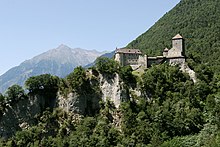
The region features a large number of castles and churches. Many of the castles were built by the local nobility and the Habsburg rulers. See List of castles in South Tyrol.
Sports
South Tyrolean athletes are very successful at winter sports. Reinhold Messner, widely regarded as the greatest mountain climber of all time, is the first climber to conquer the 14 highest mountains in the world, many of them, including the highest Everest, without the use of Oxygen. Armin Zöggeler is a famous Italian luger and double olympic champion. Carolina Kostner is a talented figure skater. HC Interspar Bolzano-Bozen Foxes are one of Italy's most successful ice hockey teams.
A German- and Ladin-speaking football team from South Tyrol played in the tournament for European minorities in Switzerland in 2008. The inaugural Europeada 2008 was won by this team (using the name South Tyrol) after beating the Croats in Serbia and the Roma team in the finals and semi-finals, respectively.
References
- ^ Cortina d'Ampezzo, Livinallongo del Col di Lana and Colle Santa Lucia, formerly parts of Tyrol, now belong to the region of Veneto
- ^ Romeo, Carlo (2000), "Il fiume all'ombra del castello. Il concetto di Alto Adige", in Arbeitsgruppe Regionalgeschichte/Gruppo di ricerca per la storia regionale (ed.), Tirol — Trentino. Eine Begriffsgeschichte/Semantica di un concetto, Geschichte und Region/Storia e regione 9, Vienna and Bozen/Bolzano: Folio, p. 139, ISBN 3-85256-149-3
- ^ Steininger, Rolf (2003), South Tyrol: A Minority Conflict of the Twentieth Century, New Brunswick, New Jersey: Transaction Publishers, p. 21, ISBN 9780765808004
- ^ Heiss, Hans (2003), "Von der Provinz zum Land. Südtirols Zweite Autonomie", in Solderer, Gottfried (ed.), Das 20. Jahrhundert in Südtirol. 1980 - 2000, vol. V, Bozen/Bolzano: Raetia, p. 50, ISBN 9788872832042
- ^ Website of the Province
- ^ Heiss, Hans; Pfeifer, Gustav (2000), "Man pflegt Südtirol zu sagen und meint, damit wäre alles gesagt. Beiträge zu einer Geschichte des Begriffes Südtirol", in Arbeitsgruppe Regionalgeschichte/Gruppo di ricerca per la storia regionale (ed.), Tirol — Trentino. Eine Begriffsgeschichte/Semantica di un concetto, Geschichte und Region/Storia e regione 9, Vienna and Bozen/Bolzano: Folio, p. 107, ISBN 3-85256-149-3
- ^ Bondi, Sandro (25 January 2011), Lettera del ministro per i beni culturali Bondi al presidente del consiglio Durnwalder (Letter) (in Italian), Rome: Il Ministro per i Beni e le Attività Culturali, retrieved 4 June 2011
- ^ Anthony Alcock. "The South Tyrol Autonomy. A Short Introduction" (PDF). Retrieved 2007-11-14. [dead link]
- ^ Rolf Steininger: "South Tyrol: A Minority Conflict of the Twentieth Century", Transaction Publishers, 2003, ISBN 9780765808004, pp.2
- ^ "Praga e Bratislava più ricche di Bolzano". Retrieved 2011-04-11.
- ^ "Tbilisi's S.Ossetia Diplomatic Offensive Gains Momentum". Archived from the original on 2007-10-08. Retrieved 2007-11-14.
- ^ "Province Statistics". Italian institute of statistics (Istat). Retrieved 2007-07-06.
- ^ "Special Statute for Trentino-Alto Adige" (PDF). Archived from the original (PDF) on 2007-09-26. Retrieved 2007-11-14.
- ^ "Official homepage in German". Retrieved 2007-11-14.
- ^ "Official homepage in Italian". Retrieved 2007-11-14.
- ^ "Official homepage in Ladin". Retrieved 2007-11-14.
- ^ "Official homepage in German". Retrieved 2007-11-14.
- ^ "Official homepage in Italian". Retrieved 2007-11-14.
- ^ Regional GDP per inhabitant in the EU27, 2009
- ^ Steininger, Rolf (2003), South Tyrol: A Minority Conflict of the Twentieth Century, New Brunswick, New Jersey: Transaction Publishers, p. 21-46, ISBN 9780765808004
- ^ Oscar Benvenuto (ed.): "South Tyrol in Figures 2008", Provincial Statistics Institute of the Autonomous Province of South Tyrol, Bozen/Bolzano 2007, p. 19, Table 11
- ^ Steininger, Rolf (2003). South Tyrol, A Minority Conflict of the Twentieth Century. Transaction Publishers. ISBN 0-7658-0800-5.
- ^ "South Tyrol in figures" (PDF). Table 9 — Declarations of which language group belong to/affiliated to — Population Census 2001. Retrieved 2007-11-15.


